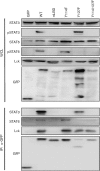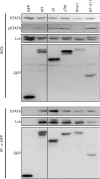Activation of the STAT6 transcription factor in Jurkat T-cells by the herpesvirus saimiri Tip protein
- PMID: 22012462
- PMCID: PMC3352339
- DOI: 10.1099/vir.0.036087-0
Activation of the STAT6 transcription factor in Jurkat T-cells by the herpesvirus saimiri Tip protein
Abstract
Herpesvirus saimiri (HVS), a T-lymphotropic monkey herpesvirus, induces fulminant T-cell lymphoma in non-natural primate hosts. In addition, it can immortalize human T-cells in vitro. HVS tyrosine kinase-interacting protein (Tip) is an essential viral gene required for T-cell transformation both in vitro and in vivo. In this study, we found that Tip interacts with the STAT6 transcription factor and induces phosphorylation of STAT6 in T-cells. The interaction with STAT6 requires the Tyr(127) residue and Lck-binding domain of Tip, which are indispensable for interleukin (IL)-2-independent T-cell transformation by HVS. It was also demonstrated that Tip induces nuclear translocation of STAT6, as well as activation of STAT6-dependent transcription in Jurkat T-cells. Interestingly, the phosphorylated STAT6 mainly colocalized with vesicles containing Tip within T-cells, but was barely detectable in the nucleus. However, nuclear translocation of phospho-STAT6 and transcriptional activation of STAT6 by IL-4 stimulation were not affected significantly in T-cells expressing Tip. Collectively, these findings suggest that the constitutive activation of STAT6 by Tip in T-cells may contribute to IL-2-independent T-cell transformation by HVS.
Figures







Similar articles
-
Growth transformation of human T cells by herpesvirus saimiri requires multiple Tip-Lck interaction motifs.J Virol. 2006 Oct;80(20):9934-42. doi: 10.1128/JVI.01112-06. J Virol. 2006. PMID: 17005671 Free PMC article.
-
The herpesvirus saimiri tip484 and tip488 proteins both stimulate lck tyrosine protein kinase activity in vivo and in vitro.Virology. 2002 Jun 5;297(2):281-8. doi: 10.1006/viro.2002.1419. Virology. 2002. PMID: 12083826
-
T-cell growth transformation by herpesvirus saimiri is independent of STAT3 activation.J Virol. 2005 May;79(9):5713-20. doi: 10.1128/JVI.79.9.5713-5720.2005. J Virol. 2005. PMID: 15827186 Free PMC article.
-
Lck protein tyrosine kinase is a key regulator of T-cell activation and a target for signal intervention by Herpesvirus saimiri and other viral gene products.Eur J Biochem. 2000 Jun;267(12):3413-21. doi: 10.1046/j.1432-1327.2000.01412.x. Eur J Biochem. 2000. PMID: 10848956 Review.
-
Herpesvirus saimiri.Philos Trans R Soc Lond B Biol Sci. 2001 Apr 29;356(1408):545-67. doi: 10.1098/rstb.2000.0780. Philos Trans R Soc Lond B Biol Sci. 2001. PMID: 11313011 Free PMC article. Review.
Cited by
-
A molecular model for the differential activation of STAT3 and STAT6 by the herpesviral oncoprotein tip.PLoS One. 2012;7(4):e34306. doi: 10.1371/journal.pone.0034306. Epub 2012 Apr 3. PLoS One. 2012. PMID: 22509288 Free PMC article.
-
Constitutive Activation of Interleukin-13/STAT6 Contributes to Kaposi's Sarcoma-Associated Herpesvirus-Related Primary Effusion Lymphoma Cell Proliferation and Survival.J Virol. 2015 Oct;89(20):10416-26. doi: 10.1128/JVI.01525-15. Epub 2015 Aug 5. J Virol. 2015. PMID: 26246572 Free PMC article.
-
Human germline heterozygous gain-of-function STAT6 variants cause severe allergic disease.J Exp Med. 2023 May 1;220(5):e20221755. doi: 10.1084/jem.20221755. Epub 2023 Mar 8. J Exp Med. 2023. PMID: 36884218 Free PMC article.
-
Viral proteins and Src family kinases: Mechanisms of pathogenicity from a "liaison dangereuse".World J Virol. 2013 May 12;2(2):71-8. doi: 10.5501/wjv.v2.i2.71. World J Virol. 2013. PMID: 24175231 Free PMC article. Review.
-
Nuclear Localization and Cleavage of STAT6 Is Induced by Kaposi's Sarcoma-Associated Herpesvirus for Viral Latency.PLoS Pathog. 2017 Jan 18;13(1):e1006124. doi: 10.1371/journal.ppat.1006124. eCollection 2017 Jan. PLoS Pathog. 2017. PMID: 28099521 Free PMC article.
References
-
- Biesinger B., Tsygankov A. Y., Fickenscher H., Emmrich F., Fleckenstein B., Bolen J. B., Bröker B. M. (1995). The product of the Herpesvirus saimiri open reading frame 1 (Tip) interacts with T cell-specific kinase p56lck in transformed cells. J Biol Chem 270, 4729–4734 10.1074/jbc.270.9.4729 - DOI - PubMed
Publication types
MeSH terms
Substances
Grants and funding
LinkOut - more resources
Full Text Sources
Research Materials
Miscellaneous

